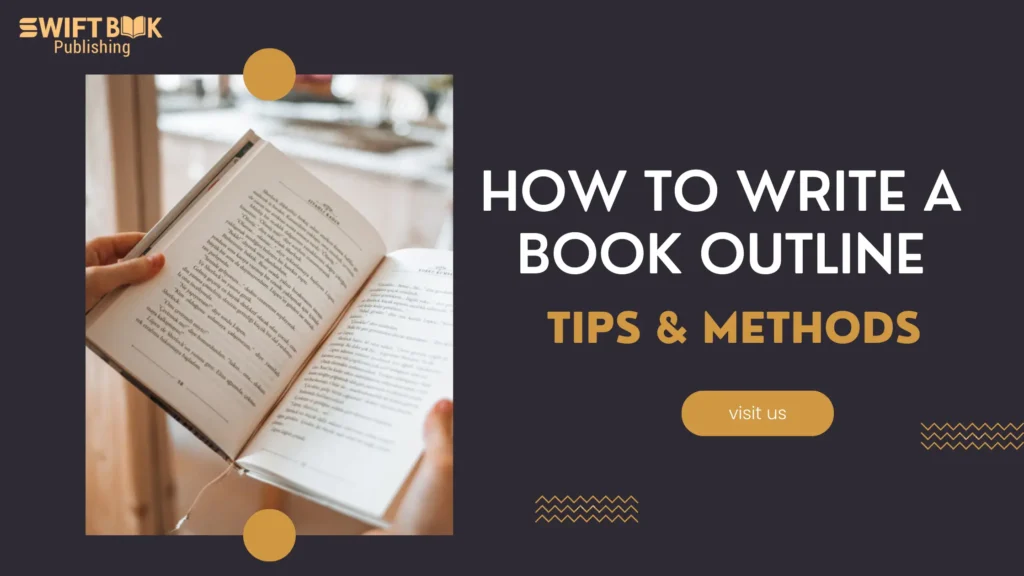Imagine sitting down to write your book, brimming with ideas, but as you start typing, you realize you’re not sure where your story is headed. The plot feels jumbled, characters are inconsistent, and you’re overwhelmed by the sheer volume of ideas.
Sounds familiar? This is a common struggle for many writers who attempt to craft a book without an outline.
Creating a book outline offers numerous benefits, including better organization, clarity, and focus. It acts as a roadmap, guiding you through each chapter and ensuring your story stays on track. Whether you’re writing fiction, non-fiction, or a novel, an outline will save you from potential pitfalls along the way.
This post will guide you through the process of creating a comprehensive book outline that will set you up for writing success.
Why Outline Your Book?
Outlining your book is more than just a preliminary step; it’s the foundation of your writing process. Here’s why:
- A book outline helps you avoid the dreaded blank page syndrome by giving you a clear path to follow. With a structured plan, you’re less likely to get stuck and can write more efficiently.
- Whether you’re figuring out how to write a book outline for fiction or non-fiction, having a clear structure keeps your narrative cohesive. This ensures that your plot develops logically and that all story elements are interconnected.
- As you create your outline of books, you can spot any gaps or contradictions in your storyline before they become major issues. This proactive approach saves you from extensive revisions later.
- Breaking down your book into smaller sections through an outline makes the task of writing a full manuscript less difficult. You’ll find it easier to tackle each chapter or scene, knowing exactly what needs to happen.
By understanding the importance of a book outline, you’re already one step closer to crafting a successful manuscript.
Different Types of Outlines
When it comes to outlining your book, there’s no one-size-fits-all approach. Different eBook writers have different preferences, and the type of book outline you choose should align with your writing style and the nature of your story.
Here are some popular outlining methods to consider:
- Basic Outline: The basic outline helps you stay focused on the key events in your story, making it easier to maintain a consistent narrative.
- Character-Driven Outline: This method emphasizes character arcs and motivations, ensuring that each character’s journey is well thought out.
- Plot-Driven Outline: This type of outline emphasizes the sequence of events, ensuring that each plot point logically leads to the next. It’s particularly useful for genres like mystery, thriller, or science fiction, where the plot is the driving force behind the story.
- Snowflake Method: The Snowflake Method starts with a one-sentence summary of your story and gradually expands it into a full outline.
- Mind Mapping: For those who prefer a more visual approach, mind mapping is an excellent option. This method involves creating a visual representation of your ideas and how they connect to each other. Mind mapping can be particularly useful for brainstorming and organizing complex stories with multiple plotlines or themes.
Each of these books outline methods offers a unique way to organize your thoughts and structure your story. Whether you’re writing a novel, a non-fiction book, or any other type of manuscript, choosing the right outline method can set you on the path to success.
How to Write a Non-Fiction Book Outline
Outlining your non-fiction book is like creating a roadmap for your readers. It helps you organize your thoughts, ensures a logical flow of information, and keeps you on track throughout the writing process. Here’s a step-by-step guide to crafting an effective outline for your non-fiction masterpiece:
Step 1: Define Your Topic and Purpose
Before diving into the details, you need a clear understanding of your book’s core. Ask yourself these fundamental questions:
- What is the central theme of your book? What specific topic are you exploring?
- What do you want your readers to learn or gain from reading your book? What message or takeaway do you want to leave them with?
- What is your unique perspective or angle on this topic? What sets your book apart from others in the same genre?
Answering these questions will solidify your focus and provide a clear direction for your outline.
Step 2: Conduct Thorough Research
Once you’ve defined your topic and purpose, it’s time to delve into research. This is crucial for building a credible and informative non-fiction book.
- Gather information from reliable sources: Books, academic journals, reputable websites, expert interviews, and even personal experiences can all contribute to your research.
- Organize your findings: Use a system that works for you, whether it’s note-taking software, index cards, or spreadsheets. Categorize your research by chapter or topic to make it easily accessible.
- Fact-check everything: Accuracy is paramount in non-fiction. Double-check your information and cite your sources meticulously.
Step 3: Structure Your Chapters Logically
With your research in hand, you can now structure your chapters in a way that makes sense for your topic and purpose.
- Think about the natural progression of information: How can you guide your readers through the subject matter in a clear and engaging way?
- Consider using a chronological, thematic, or problem-solution approach: Choose a structure that best suits your content and target audience.
- Create chapter titles and subheadings: This will help you visualize the overall structure and ensure a logical flow of information.
Step 4: Develop Key Arguments and Supporting Evidence
Each chapter should have a central argument or main point that contributes to the overall message of your book.
- Outline the key arguments for each chapter: What are the main takeaways you want readers to grasp?
- Support your arguments with evidence: Use your research findings, statistics, anecdotes, and examples to back up your claims and make your arguments compelling.
- Ensure a balance between information and analysis: Don’t just present facts; provide your own insights and interpretations to add depth and value to your book.
Step 5: Consider Your Target Audience
Understanding your target audience is crucial for crafting a book that resonates with them.
- Who are you writing for? What is their level of knowledge on the subject? What are their interests and expectations?
- Adjust your language and complexity accordingly: Use clear and concise language that your audience can easily understand. Avoid jargon or technical terms unless necessary, and define them clearly if you do.
- Tailor your examples and anecdotes to your audience’s interests: This will help them connect with your message on a personal level.
By following these steps, you’ll create a solid non-fiction book outline that will serve as a blueprint for your writing journey.
How to Write a Fiction Book Outline
Creating a compelling fiction book outline is like building a strong foundation for a captivating story. It allows you to map out the key elements of your narrative, ensuring a cohesive and engaging reading experience. Here’s a detailed guide to crafting a fiction book outline that will bring your story to life:
Step 1: Develop Your Premise and Core Conflict
The premise is the foundation of your story, the core idea that drives the narrative forward. It should be concise and intriguing, capturing the essence of your plot.
- What is the central conflict your protagonist will face? What obstacles must they overcome?
- What is at stake for your protagonist? What will they lose if they fail?
- What is the main question your story seeks to answer? What mystery or dilemma will keep readers engaged?
Defining your premise and core conflict will provide a clear direction for your outline and ensure a focused narrative.
Step 2: Create Compelling Characters
Characters are the lifeblood of fiction. They drive the plot, evoke emotions, and connect with readers on a personal level.
- Develop detailed character profiles for your main characters: Include their backstories, motivations, strengths, weaknesses, and relationships with other characters.
- Consider their goals, desires, and fears: What drives them? What are they striving for? What are they afraid of?
- Explore their internal conflicts: What inner struggles do they face? How do these conflicts shape their actions and decisions?
Creating compelling characters will make your story more engaging and relatable.
Step 3: Create a Plot Outline
A well-structured plot is essential for keeping readers hooked. Consider using the Three-Act Structure or other narrative frameworks to guide your outline.
- Act I: Setup: Introduce your characters, setting, and initial conflict. Establish the protagonist’s goals and motivations.
- Act II: Rising Action: Develop the conflict, introduce obstacles, and raise the stakes.
- Act III: Climax, Falling Action, and Resolution: The climax is the peak of the conflict, followed by the falling action and resolution, where the loose ends are tied up.
Map out the key events of your story, ensuring a clear progression and satisfying conclusion.
Step 4: Outline Individual Chapters
Breaking down your plot into individual chapters allows you to focus on pacing and tension.
- Outline the main events of each chapter: What happens? Who are the key characters involved?
- Consider the chapter’s purpose: How does it contribute to the overall plot? What information is revealed?
- Focus on creating rising tension and cliffhangers: Keep readers engaged by ending chapters with unanswered questions or unresolved conflicts.
Step 5: Consider Subplots and Themes
Subplots and themes add layers of depth and complexity to your story.
- These secondary storylines can introduce new characters, explore different aspects of the world, and provide additional conflict.
- What messages or ideas do you want to convey through your story?
- Don’t force them; let them emerge naturally from the characters’ actions and experiences.
Remember, outlining is a flexible process, so don’t be afraid to deviate from your plan if inspiration strikes.
How to Write a Novel Outline
Writing a novel requires a robust outline that not only guides the plot but also delves into the intricacies of character development, worldbuilding, and pacing. This section expands on the previous fiction outline steps, focusing on the unique challenges and opportunities of long-form storytelling:
Worldbuilding
In a novel, the setting is more than just a backdrop; it’s a living, breathing entity that influences the characters and plot. Detailed worldbuilding is crucial for immersing readers in your story.
- Develop a rich and consistent world: Consider the geography, history, culture, politics, and social structures of your fictional world.
- Create unique rules and limitations: What are the laws of physics? What are the social norms and taboos?
- Use sensory details to bring your world to life: Describe the sights, sounds, smells, tastes, and textures of your setting.
- Show, don’t tell: Let readers experience your world through the characters’ actions and interactions.
Character Arcs
Character arcs are essential for adding depth and meaning to your novel. They allow readers to witness the growth and transformation of your characters as they face challenges and overcome obstacles.
- Map out the internal and external changes your characters will undergo: How will they evolve throughout the story?
- Identify the key turning points in their journey: What events will force them to confront their flaws and make difficult choices?
- Consider their motivations and how they might shift: What drives them at the beginning of the story? How do their goals and desires change as they progress?
- Ensure their growth feels organic and believable: Avoid sudden or unrealistic transformations.
Pacing and Plot Twists
Pacing is crucial for maintaining reader engagement in a long-form narrative. A well-paced novel balances moments of action and suspense with slower, more introspective scenes.
- Vary the pace to create a dynamic reading experience: Alternate between fast-paced action sequences and slower, character-driven moments.
- Strategically place plot twists to surprise and intrigue readers: Avoid predictability; introduce unexpected turns of events that challenge the characters and keep the story fresh.
- Use foreshadowing to hint at future events: This creates anticipation and keeps readers guessing.
- Consider cliffhangers at the end of chapters to encourage readers to keep turning the pages: Leave them wanting more.
Expanding on the Previous Steps
- Premise and Core Conflict: In a novel, the core conflict should be complex and multifaceted, with multiple layers that unfold throughout the story.
- Character Creation: Develop a wider range of characters, including secondary characters with their own motivations and arcs.
- Plot Outline: Break down the plot into more detailed acts and sequences, ensuring a clear progression and satisfying resolution.
- Individual Chapters: Focus on crafting compelling scenes with vivid descriptions and engaging dialogue.
- Subplots and Themes: Explore multiple subplots that intertwine with the main plot and contribute to the overall themes of the novel.
By focusing on these key elements, your novel outline will become a robust blueprint for a captivating and unforgettable story. Remember, outlining is a fluid process, so allow yourself to adapt and refine your plan as you delve deeper into your novel’s world and characters.
Related Blog: 21 Outstanding Books Opening Lines That Define Literary Excellence
Book Outline Tips
No matter what genre you’re working in, a well-crafted book outline is essential for staying organized and focused throughout the writing process. Here are some general tips that apply to all types of books:
- Start with a Flexible Outline: While it’s important to have a plan, remember that your book outline doesn’t have to be set in stone. Be prepared to adapt and adjust your outline as you write. Characters might take on a life of their own, or new ideas might emerge that enhance your story. Flexibility allows your creativity to flow while keeping your narrative on track.
- Use Different Outline Formats: Don’t limit yourself to just one type of outline. Experiment with different formats like mind maps, spreadsheets, or index cards to see which works best for you. A mind map can help you visualize connections between ideas, while a spreadsheet might be better for tracking plot points or character arcs. Books outline formats are as varied as the stories they help create, so find what suits your style.
- Focus on the Big Picture: During the outlining stage, it’s easy to get bogged down in minor details, but try to keep your focus on the big picture. Your book outline should provide a clear overview of the story’s main events, character development, and themes. The finer details can be worked out during the writing process. This approach helps prevent overwhelm and keeps your outline manageable.
- Consider Using Software: There are many tools available that can make the outlining process easier and more efficient. Software like Scrivener, Plottr, or even simple word processors can help you organize your thoughts, track progress, and easily rearrange sections of your outline of books. These tools often come with features specifically designed for writers, making them valuable resources for both beginners and experienced authors.
By keeping these Book Outline tips in mind, you can create a strong, flexible outline that serves as the backbone of your writing project, no matter the genre.
Wrapping up
Creating a book outline is a crucial step in the writing process, regardless of the genre or style of your book. By outlining your story, you gain clarity, structure, and direction, which can save you time and reduce the chances of writer’s block. Whether you choose a basic outline, a character-driven outline, or another method, the key is to find a system that works for you and supports your creative process.
Remember, your outline is a flexible tool designed to guide you, so don’t be afraid to adapt it as your story evolves. With a solid outline in place, you’ll be well on your way to crafting a compelling and well-organized manuscript.







